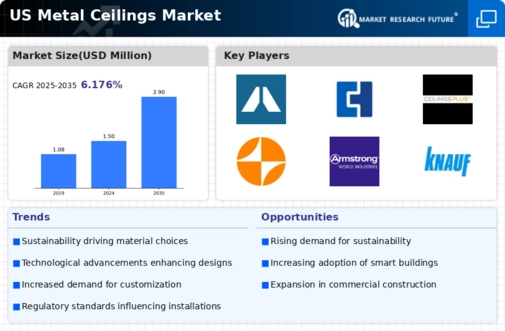Rising Demand for Aesthetic Appeal
The metal ceilings market is experiencing a notable increase in demand driven by the growing emphasis on aesthetic appeal in commercial and residential spaces. Architects and designers are increasingly incorporating metal ceilings into their projects to achieve a modern and sophisticated look. This trend is particularly evident in sectors such as hospitality and retail, where visual impact is paramount. The market for metal ceilings is projected to grow at a CAGR of approximately 6.5% from 2025 to 2030, indicating a robust interest in innovative design solutions. As consumers seek unique and visually striking environments, the metal ceilings market is likely to benefit from this shift towards enhanced aesthetics.
Growing Awareness of Indoor Air Quality
The metal ceilings market is increasingly influenced by the growing awareness of indoor air quality (IAQ) among consumers and businesses. Metal ceilings are often perceived as a healthier alternative to traditional materials, as they do not harbor dust, allergens, or mold. This characteristic is particularly appealing in environments such as schools and healthcare facilities, where IAQ is critical. As more stakeholders prioritize health and wellness in building design, the demand for metal ceilings is expected to rise. The market could see a potential increase of 10% in demand as awareness of IAQ continues to shape consumer choices.
Regulatory Support for Energy Efficiency
The metal ceilings market is benefiting from increasing regulatory support aimed at enhancing energy efficiency in buildings. Various state and federal initiatives encourage the use of materials that contribute to energy savings, and metal ceilings are often recognized for their reflective properties that can improve lighting efficiency. This regulatory environment is likely to drive demand for metal ceilings, as builders and developers seek to comply with energy codes and standards. The market is projected to expand as more construction projects incorporate energy-efficient designs, potentially increasing the market share of metal ceilings by 15% over the next five years.
Technological Innovations in Manufacturing
Technological advancements in manufacturing processes are playing a pivotal role in shaping the metal ceilings market. Innovations such as advanced coating techniques and automated production lines are enhancing the quality and variety of metal ceiling products available. These improvements not only increase production efficiency but also allow for greater customization options, catering to diverse consumer preferences. As manufacturers adopt cutting-edge technologies, the metal ceilings market is likely to see an influx of new designs and finishes, appealing to a broader audience. This trend may contribute to a projected market growth of 7% annually through 2030.
Increased Focus on Durability and Maintenance
Durability and low maintenance requirements are becoming critical factors influencing the metal ceilings market. Metal ceilings are known for their resilience against wear and tear, making them an attractive option for high-traffic areas. This durability translates into cost savings over time, as the need for frequent replacements or repairs is minimized. The market is witnessing a shift towards materials that offer longevity, with metal ceilings often outperforming traditional materials in this regard. As businesses and homeowners prioritize long-term investments, the metal ceilings market is expected to see sustained growth, with an estimated market value reaching $1.2 billion by 2030.


















Leave a Comment